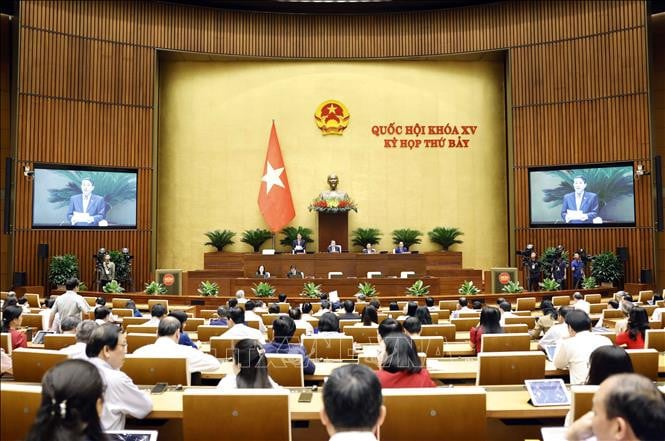
On May 25, the National Assembly discussed in the hall the Report of the Supervisory Delegation related to the implementation of Resolution 43. Delegates assessed that the effectiveness of tax policies is one of the bright spots. However, regarding the limitations related to investment capital disbursement, preferential loan packages with 2% interest rates... there are still concerns about the ability to absorb policies, processes and procedures that affect implementation efficiency.
Delegate Ha Sy Dong: Tax policy efficiency is a bright spot
Resolution 43 in early 2022 and is expected to be implemented in 2022 and 2023 with the goal of economic recovery after COVID-19. If there was only COVID-19, these policy packages would not be necessary, due to the fact that in 2022 the economy at that time had excess capital and very low interest rates. The support packages also did not have the effect of stimulating growth, but in addition to COVID-19, the economy in 2022 and 2023 had other problems such as war, global economic fluctuations... so in the end this support package was somewhat effective.
In addition, the slow implementation of Resolution 43 is not entirely a limitation. Because if it is strongly implemented in early 2022 when it is first issued, Resolution 43 will add to the "asset bubble" that is already expanding. But because of the slow implementation, when the "bubble" has passed its peak and begun the "landing" process, Resolution 43 has the effect of helping Vietnam "soft landing" instead of "hard landing" like many other countries.
The 2% interest rate reduction package has only disbursed more than 3%, but in some ways it is not a failure. If this package works well, it will certainly be much more difficult to deal with inflation in 2022. As the 2009 stimulus package caused inflation in 2011.
In the context of tightening discipline and discipline, the enforcement apparatus should prioritize feasibility. And the 2% interest rate support package could not be implemented because it was not feasible. Meanwhile, the VAT reduction package was highly effective because this measure was based on existing tax procedures.
The VAT reduction also has problems in classifying which sectors are at 8% and which are at 10%. If we had to do it again, it would probably be better to reduce it to 8%. The Government 's management has been very flexible. Extending tax payment until the end of the year is a very practical solution because businesses can borrow a short-term loan with 0% interest and it has a great effect, especially when inflation is high and bank loan procedures are difficult.
In fiscal policies, tax exemptions and tax deferrals are highly effective because they are easy to implement. However, policies on spending money from the budget such as public investment and interest rate support are less effective. Other countries use public investment policies to recover the economy very effectively, but Vietnam has encountered legal bottlenecks and tightened discipline, so public investment cannot fully exert its effect.
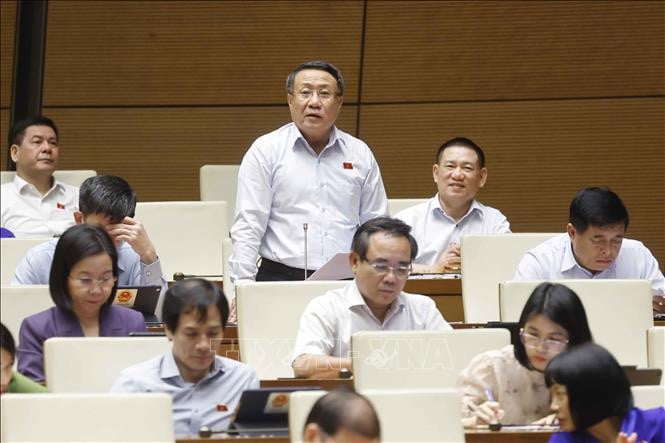
In particular, it is necessary to focus on feasibility and timing because this is very important for macroeconomic policy. A policy may be correct in January but may not be correct in March when the inflation growth trend is different. Therefore, if in the future there are programs and packages to support the macro economy, the timing factor must be carefully considered to put the policy into practice.
Delegate Nguyen Ngoc Son: Policy needs to ensure fast and targeted absorption
The National Assembly's monitoring report has fully demonstrated the achievements, both the shortcomings and limitations in the implementation of Resolution 43 and the Resolutions on national key projects. There are two particularly impressive policies: tax reduction and interest rate support through the Social Policy Bank. These policies have helped many beneficiaries overcome difficulties and obstacles to operate normally.
However, with 7 policies that are quantified and expressed in Resolution 43, there are policies that have not really been effective. Evidence such as policies related to commercial bank interest rate support and the use of public telecommunications funds have not been effective. Another policy is the disbursement for development investment projects that has not met expectations, with the figure reaching only 56%.
I think that after this time, the National Assembly will pass a Resolution to serve as a basis for the Government to continue organizing and implementing. Thus, there will be a more comprehensive view. When applying specific mechanisms to key national projects in the 8 projects that the National Assembly supervises, many mechanisms have been effective and helped speed up the progress of the projects.
However, the monitoring results also pointed out the shortcomings and limitations in the organization and implementation of these projects. Most notably, compensation, support and resettlement have not been fully implemented. Currently, the exploitation of materials is lacking, especially when there is a specific mechanism in place and applied but it is still not as expected.
Regarding the lessons learned in designing and implementing policies in urgent situations, it is necessary to pay attention to the nature of suitability to reality and the resources that must be absorbed during the application of this specific policy. It should be considered that, when applying a specific policy, it is not to replace the stable legal system but only to help the legal policy be implemented at the desired time.
For example, Resolution 43 only applies that mechanism for 2 years. After that, the normal legal system will return. If the special mechanism is found to be effective, it is necessary to summarize and evaluate it to amend the law in the system later. Avoid applying a special mechanism at a time of promotion like Resolution 43 and then extending it for another 2-3 years, which I think is inappropriate. When building policies, it is necessary to ensure quick absorption, in line with the goals set out in the Resolution and policies.
Delegate Nguyen Thi Viet Nga: Delayed and late issuance of guidelines leads to low disbursement, not reaching the target
Through research reports combined with the implementation of monitoring of this content in localities, it is shown that the issuance of legal documents and specific guidance documents for implementing Resolution 43 is still slow. Statistics from the National Assembly also show that not only some policy guidance documents are slow, but most documents are issued slowly.
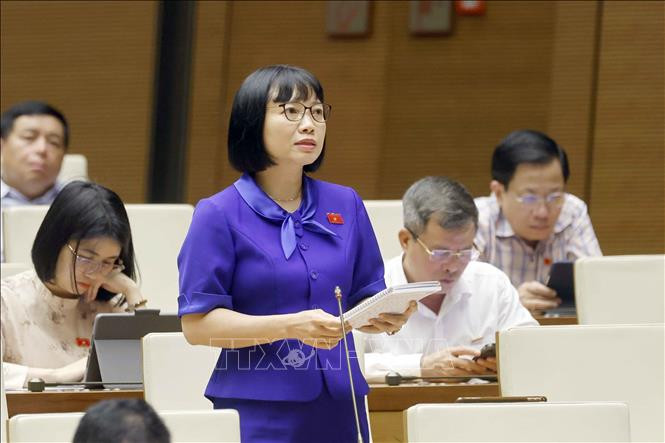
Of the 21 documents listed in the appendix, only one was issued on time, the remaining 20 were delayed or late. Of the 20 delayed documents, although 4 did not have a specific deadline, they were issued very late. Resolution 43, which has a 2-year deadline, took exactly 1 year to issue the document. Many documents were delayed from 2 months to 7 months.
Resolution 43 of the National Assembly was issued in an urgent situation to carry out urgent tasks, in a time pressure of 2 years, but the issuance of legal documents was still delayed, late as before. The delay, late issuance of these legal documents is the direct cause leading to low disbursement rate, some policies have not achieved the set goals, affecting the overall results.
Therefore, the National Assembly continues to monitor the review of responsibilities of organizations and individuals in the above-mentioned shortcomings and limitations. Only when there is a serious review will the shortcomings and limitations not be repeated, especially the delay in issuing documents.
Delegate Nguyen Quang Huan: Process affects progress
According to the National Assembly's supervision, in addition to positive results, there are still some limitations; including slow disbursement progress. This requires further analysis of the cause because almost every session raises the issue of slow disbursement progress, but it is somewhat qualitative.
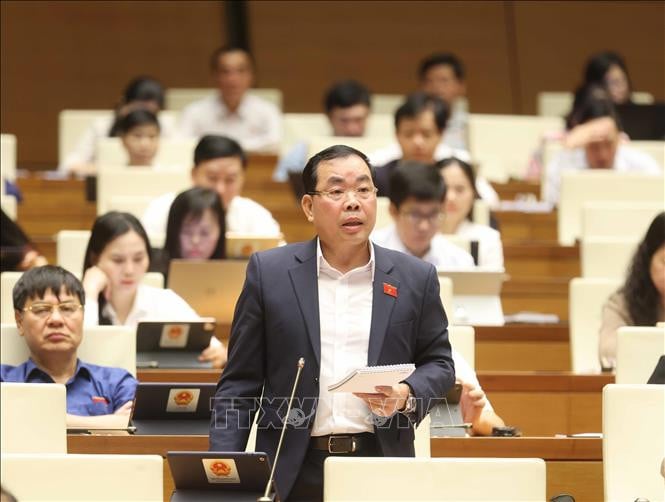
When giving the right reasons, there are a number of items but still need to specify the percentage of fast and slow results to have more specific solutions. For example, when analyzing slow disbursement, the slowness is due to the economy not being able to absorb or the time is too short for the economy to absorb. There are places that can absorb so consider transferring. A series of questions need to be answered thoroughly.
Or how does the process affect the slow progress? The Government has submitted the list of projects to the National Assembly Standing Committee 5 times. If a state of emergency is declared, the National Assembly will only allocate the budget, but the decision on choosing the project or how to do it is the Government's job. The National Assembly can only supervise and check that the capital is put into the project for the right purpose.
In addition, there is the issue of procedures. Currently, administrative procedures in some places require special mechanisms for quick resolution. This proves that without special mechanisms, the procedures take a long time. Therefore, it is necessary to study procedural reforms to speed up disbursement.
Source








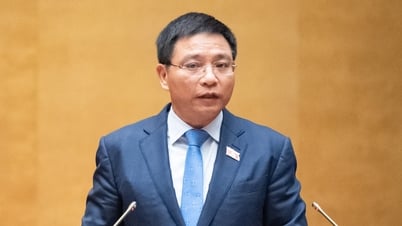

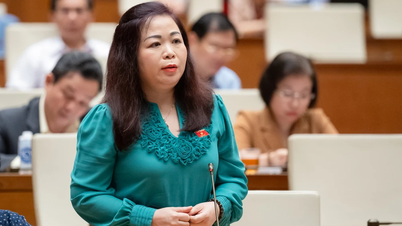



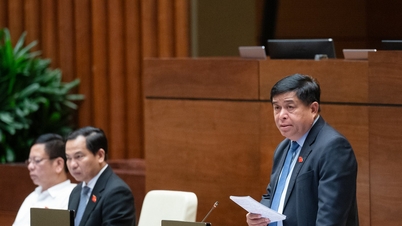


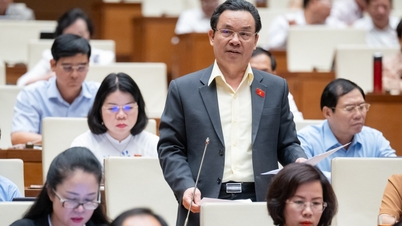




























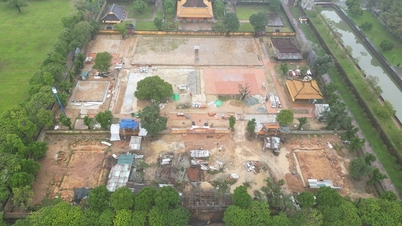



































































Comment (0)